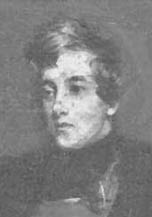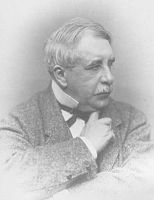 Thomas Gold Appleton (March 31, 1812-April 17, 1884) wrote that in his day, “forms of luxury and self-indulgence displace the severe austerities of our fathers; but under it all still lives the New England conscience.” His words apply to his own career as an essayist, amateur artist and poet, collector and patron of the arts, and a celebrated Boston character or “wit.” He is remembered chiefly for his generous support of the Boston Public Library and Museum of Fine Arts.
Thomas Gold Appleton (March 31, 1812-April 17, 1884) wrote that in his day, “forms of luxury and self-indulgence displace the severe austerities of our fathers; but under it all still lives the New England conscience.” His words apply to his own career as an essayist, amateur artist and poet, collector and patron of the arts, and a celebrated Boston character or “wit.” He is remembered chiefly for his generous support of the Boston Public Library and Museum of Fine Arts.
Thomas Appleton was the oldest child of Nathan Appleton, the wealthy Boston merchant and manufacturer, and his wife Maria Theresa Gold. Tom prepared for Harvard at Round Hill, an experimental school based on the most up-to-date European educational theories. The school’s co-founder, George Bancroft, praised Tom’s writing and encouraged his literary ambitions. Upon graduation from Harvard in 1831, Tom wanted to pursue his interests in art and literature, “to enlarge my mind, to multiply my ideas, to give a wider range to thought.” To his father, this ambition seemed like “idleness.” By way of a compromise, Tom’s dutiful younger brother Charles was trained in his father’s business, while Tom remained in Cambridge, ostensibly studying law. Next he embarked on an eighteen-month European tour, including a stint as an art student in Florence.
The issue of Tom’s future remained unresolved for over a decade, during which his mother and his brother Charles died, his younger sisters married, his father remarried, and his stepmother bore three children. Meanwhile, Tom continued to travel, to dabble in painting and poetry, and to resist, without quite rejecting, his father’s efforts to interest him in business and his stepmother’s attempts to find him a wife. At 32 he asserted his independence, announcing in a letter to his father that he planned to settle in Europe and devote himself to the study of art. “I beg you not to judge me by your own standards for yourself,” he wrote. “I have not any of the kind of talent needful to success here.” He hoped his father would understand that “Europe is my Boston where I am truly at home.”
Appleton settled first in Rome, then in Paris. He wrote to his father, “I am here an artist, surrounded by artists and art.” Despite diligent study, however, he never achieved artistic success; nor did he feel as “truly at home” as he had expected. In contrast to New Englanders, whom he thought “lean, anxious, and hungry for novelty” and prone to driving themselves into a state of “dyspeptic, bitter, semi-lunacy,” he admired French and Italian friends for their appreciation of “creature-comforts; they believe seriously in dolce far niente and the body’s enjoyment.” Yet he knew that his nationality was an inescapable part of himself. “It is an odd thing how much of the cat is in all of us—a silent, unexpressed attachment to place; sometimes a hate of it,” he mused. “‘A Bostonian’ means incarnated Boston, in a way he can never know.” Homesick on both continents, he made dozens of trips across the Atlantic.
In 1857 Appleton settled in Cambridge, Massachusetts, close to his sister Fanny Longfellow and her family. Now 45, he admitted, “I have the temperament of genius without the genius.” Those who knew him well, however, thought he did possess a kind of genius: a gift for what his secretary and biographer, Susan Hale, called “the difficult art of generous living.” He enjoyed making people happy and devoted much of his fortune to giving others a good time. A lifelong bachelor, he became the center of the extended Appleton family, keeping in close contact with his nieces, nephews, and the children of his father’s second marriage. His gifts to the Longfellow children included a trip to Europe and an ocean-going yacht. In his later years virtually adopted his improvident half-brother, Nathan Appleton Jr.
Appleton was known in Boston society as a sympathetic friend, a convivial host, and a celebrated wit. Oscar Wilde quoted his most well-known bon mot, “Good Americans, when they die, go to Paris,” in his play A Woman of No Importance, 1893. Like Wilde, Appleton was said to have made conversation a work of art. Charles Eliot Norton described him as “a true bon-vivant, intellectually and well as physically.” Ralph Waldo Emerson called him “king of clubs.” Susan Hale thought his humor concealed a “shy and sensitive” nature: “For fear of being laughed at, he said and did things to turn the laugh upon him, that he might laugh himself with the others.”
 The second half of Appleton’s life was happier than the first. His essays and stories brought him a modest success; according to Oliver Wendell Holmes, Appleton “waked up, somewhat after the usual flowering time of authorship, to find himself a very agreeable and cordially welcomed writer.” To his great joy, he was reconciled with his father, who accepted his son’s pursuits as legitimate work. In his essay on labor in the United States, Nathan Appleton wrote, “A few sons of the rich inherit fortunes which enable them to dispense with labor or profitable occupation; but . . . the wisest among them . . . adopt a literary or other useful employment.”
The second half of Appleton’s life was happier than the first. His essays and stories brought him a modest success; according to Oliver Wendell Holmes, Appleton “waked up, somewhat after the usual flowering time of authorship, to find himself a very agreeable and cordially welcomed writer.” To his great joy, he was reconciled with his father, who accepted his son’s pursuits as legitimate work. In his essay on labor in the United States, Nathan Appleton wrote, “A few sons of the rich inherit fortunes which enable them to dispense with labor or profitable occupation; but . . . the wisest among them . . . adopt a literary or other useful employment.”
Most importantly, Appleton discovered the task to which he would devote the rest of his life: the effort to overcome New England’s legacy of Puritan asceticism. His dawning hope that this might be accomplished was bound up with the rediscovery of his family’s Unitarian heritage. He became an active member of the Federal Street church, praising “the twin glory of our faith with its reasonableness [and] its liberality.” In his essay “The New England Conscience,” he credited Unitarianism with redirecting the religious impulses of New Englanders away from morbid self-examination and toward works of art, science, charity, and justice. Lamenting that “the element of fun, in the works of God, is one which Religion has accepted with reluctance,” he argued that enjoyment of the gifts of the “great mother-spirit of the universe,” far from being a sin, is a religious duty.
On his return to Boston, Appleton joined a movement to make art and learning available to a wider public. In 1852, while still residing abroad, he had served on the board of trustees of the new Boston Public Library. He donated what became the basis for the library’s print collection. In 1870 he was appointed to the first board of trustees of the Boston Museum of Fine Arts, a position he held for the rest of his life. In addition to substantial monetary contributions, he donated artworks ranging from Greek and Roman antiquities to the works of contemporary American painters. He solicited contributions from his extensive social circle, urging, one friend recalled, that Bostonians needed a museum because “the sensuous side of their nature was undeveloped.” For the museum’s opening in 1876, he wrote the guide to the galleries, in which he urged visitors to contribute to the building fund so that the museum “may prove the crowning glory of the city we love.”
Thomas Appleton died of pneumonia while on a trip to New York in 1884. Oliver Wendell Holmes wrote in the Atlantic Monthly: “How sad it is to see his name stretched out at full length and shrouded with all its syllables! For Westminster Abbey did not better know Ben Jonson by his shortened appellation than Boston knew our dear familiar friend, Tom Appleton.”
The Massachusetts Historical Society has two sets of Appleton family papers: one primarily relating to Nathan Appleton, and one to Nathan Appleton Jr. Both collections contain some letters and papers of Thomas Appleton. Other letters and papers can be found at Harvard University, Yale University, the Boston Public Library, and the Longfellow National Historic Site in Cambridge, Massachusetts. Appleton’s poetry was published in Faded Leaves (1872) and Fresh Leaves (1874). A Nile Journal (1876), Syrian Sunshine (1877) contain his travel writings. His essays, articles, and stories—most of them previously published—are collected in A Sheaf of Papers (1875), Windfalls (1878), and Chequer-Work (1879). “The New England Conscience” appears in A Sheaf of Papers.
There is no really satisfactory biography, although the following books all contain biographical material: Susan Hale, Life and Letters of Thomas Gold Appleton (New York, 1885); Patricia Brunner Bois, Thomas Appleton: Artist and Patron (M.A. thesis, University of Delaware, 1972); and Louise Hall Tharp, The Appletons of Beacon Hill (1973). There are short biographical sketches in Edward Waldo Emerson, The Early Years of the Saturday Club 1855-1870 (1918); American National Biography (1999), and the Dictionary of American Biography (1932). Information about Appleton’s involvement in the Boston Public Library and Museum of Fine Arts is from: Horace G. Wadlin, The Public Library of the City of Boston: A History (1911) and Walter Muir Whitehill, Museum of Fine Arts, Boston: A Centennial History (1970).
Article by Lynn Gordon Hughes
Posted August 19, 2001